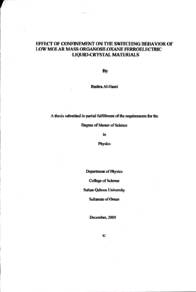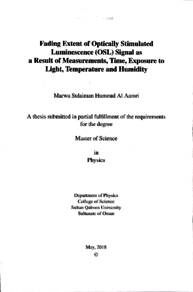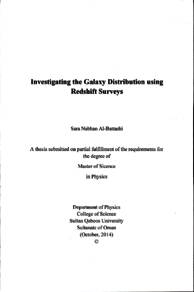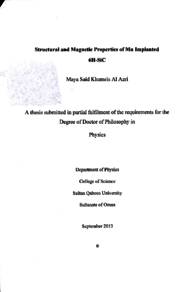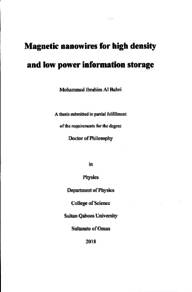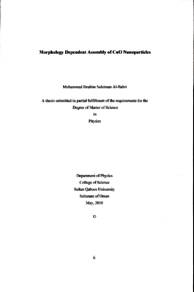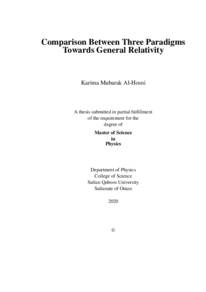Document
Effect of confinement on the switching behavior of low molar mass organosiloxane ferroelectrics liquid-crystal materials
Publisher
Sultan Qaboos University
Gregorian
2005
Language
English
Subject
English abstract
Bi-mesogen organosiloxane molecules consist of two mesogenic moieties attached
via an alkyl chain to a short (2-5 repeat units) siloxane chain. In the smectic phase
the siloxane moieties micro-separate in to layers that act as an effective polymer
backbone. The optical properties of the material depend on the conformation of bi
mesogen molecules.
The conformation adopted by the molecules depends on a delicate balance of several
conflicting factors such as the packing in the smectic phase, the constraints at
bounding surfaces or the presence of an electric field. This work is an investigation
of the electro-optic response of a novel series of chiral bi-mesogen organosiloxane.
The material with a short (5 units) spacer between the mesogen and the siloxane
behaves as a rigid unit and responds like a smectic A material. The material with 11
units in the spacer does not respond to the electric field.
When confined in a cell treated for planar alignment the material with 10 units in the
spacer displays an unusual electro-optic response. The switching occurs in several
distinct steps. At high fields the specimen displays a progressing stripe-switching
behaviour with an increase in the response time as the field is increased reaching a
few seconds at 20 V/um. We observed a significant change in the behaviour of the
tilt angle with the temperature in treated cell, while a constant value of 34 degrees is
found in untreated cell.
Possible interpretations of the observed behaviour are presented. In the proposed
model a strong anchoring at the surface and several coexisting conformations are
involved.
Member of
Resource URL
Arabic abstract
جزيئات السيلوکسان العضوي ثنائي الميزوجین (Bi - mesogen organosiloxane) تتكون من جزيئين من الميزوجين متصلين بواسطة سلسلة الألكيل(alkyl chain ) مع سلسلة صغيره من سلسلة السيلوكسان (2-5 وحدات) (siloxane chain) في طور السيمكتك (smectic phase) وتصطف أجزاء السيلوكسان على مسافة صغيرة جدا في طبقات كما أن الخصائص الضوئية لهذه المادة تعتمد على الشكل الذي تتخذه جزيئات ثنائي الميزوجين (Bi - mesogen molecules) و الشكل المفترض أن تأخذه الجزيئات يعتمد على عدة عوامل منها: معامل الامتلاء في طور السيمكتك (smectic phase)، مدى ارتباط الجزيئات بالسطح و وجود مجال كهربائي.
يشمل هذا العمل أيضا دراسة الاستجابة الكهربائية الضوئية لمواد السيلوکسان العضوي ثنائي الميزوجين ذو أطوال مختلفة لسلسلة الألكيل. ولقد وجدنا أن المادة التي طول سلسلة الألكيل فيها قصيرة (5 وحدات) تسلك سلوك الوحدة الصلبة واستجابتها للمجال الكهربائي مثل استجابة مادة سيمكتيك A والمادة التي طول سلسلة الألكيل فيها 11 وحدة لا تستجيب للمجال الكهربائي. أما عند استخدام خلية معالجة( treated cell) (اتجاه تصاف الجزيئات موحد) مع المادة التي طول سلسلة الألكيل فيها 10 وحدات فان هذه المادة تستجيب استجابة شاذة وغير متوقعه حيث تحدث الاستجابة فيها على عدة مراحل مختلفة وفي حالة وجود مجال كهربائي عالي فان العينة تستجيب للمجال على شكل شرائط(stripes) تتدفق خلال الاستجابة مع ارتفاع وقت الاستجابة (response time) مع زيادة المجال الكهربائي حتى تصل إلى 20 فولت/ ميكرومتر. كما لوحظ تغير بسيط في سلوك زاوية الميل(tilt angle) لهذه المادة مع درجة الحرارة في حالة استخدام الخلية المعالجة في حين حصلنا على قيمة ثابتة لزاوية الميل وهي 34 درجة في حالة استخدام خلية غير معالجة (Untreated cell)
وتقدم هذه الدراسة التفاسير المحتملة وراء هذا السلوك الشاذ. النموذج المعروض يتلخص في إرجاع هذا السلوك إلى الرسو القوي (strong anchoring) على السطح و احتمالية وجود عدة أشكال للجزيئات مع تغيرها خلال الاستجابة.
يشمل هذا العمل أيضا دراسة الاستجابة الكهربائية الضوئية لمواد السيلوکسان العضوي ثنائي الميزوجين ذو أطوال مختلفة لسلسلة الألكيل. ولقد وجدنا أن المادة التي طول سلسلة الألكيل فيها قصيرة (5 وحدات) تسلك سلوك الوحدة الصلبة واستجابتها للمجال الكهربائي مثل استجابة مادة سيمكتيك A والمادة التي طول سلسلة الألكيل فيها 11 وحدة لا تستجيب للمجال الكهربائي. أما عند استخدام خلية معالجة( treated cell) (اتجاه تصاف الجزيئات موحد) مع المادة التي طول سلسلة الألكيل فيها 10 وحدات فان هذه المادة تستجيب استجابة شاذة وغير متوقعه حيث تحدث الاستجابة فيها على عدة مراحل مختلفة وفي حالة وجود مجال كهربائي عالي فان العينة تستجيب للمجال على شكل شرائط(stripes) تتدفق خلال الاستجابة مع ارتفاع وقت الاستجابة (response time) مع زيادة المجال الكهربائي حتى تصل إلى 20 فولت/ ميكرومتر. كما لوحظ تغير بسيط في سلوك زاوية الميل(tilt angle) لهذه المادة مع درجة الحرارة في حالة استخدام الخلية المعالجة في حين حصلنا على قيمة ثابتة لزاوية الميل وهي 34 درجة في حالة استخدام خلية غير معالجة (Untreated cell)
وتقدم هذه الدراسة التفاسير المحتملة وراء هذا السلوك الشاذ. النموذج المعروض يتلخص في إرجاع هذا السلوك إلى الرسو القوي (strong anchoring) على السطح و احتمالية وجود عدة أشكال للجزيئات مع تغيرها خلال الاستجابة.
Category
Theses and Dissertations

